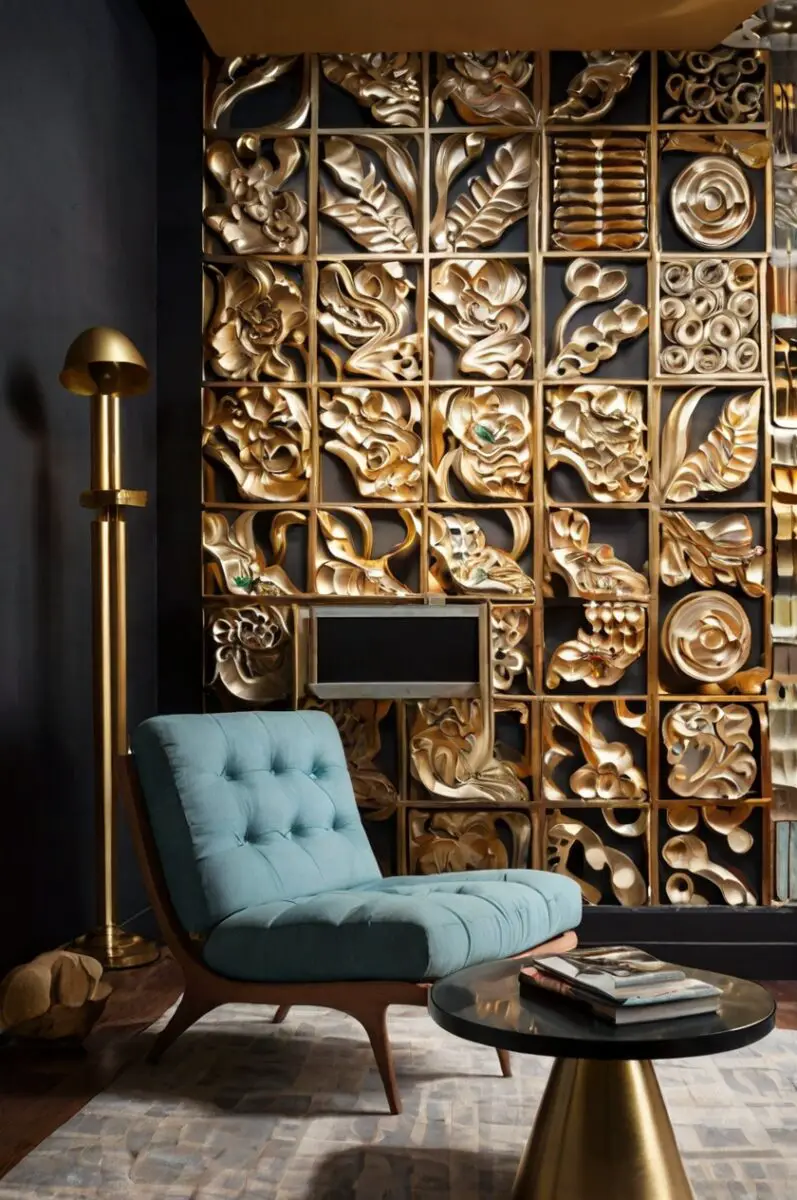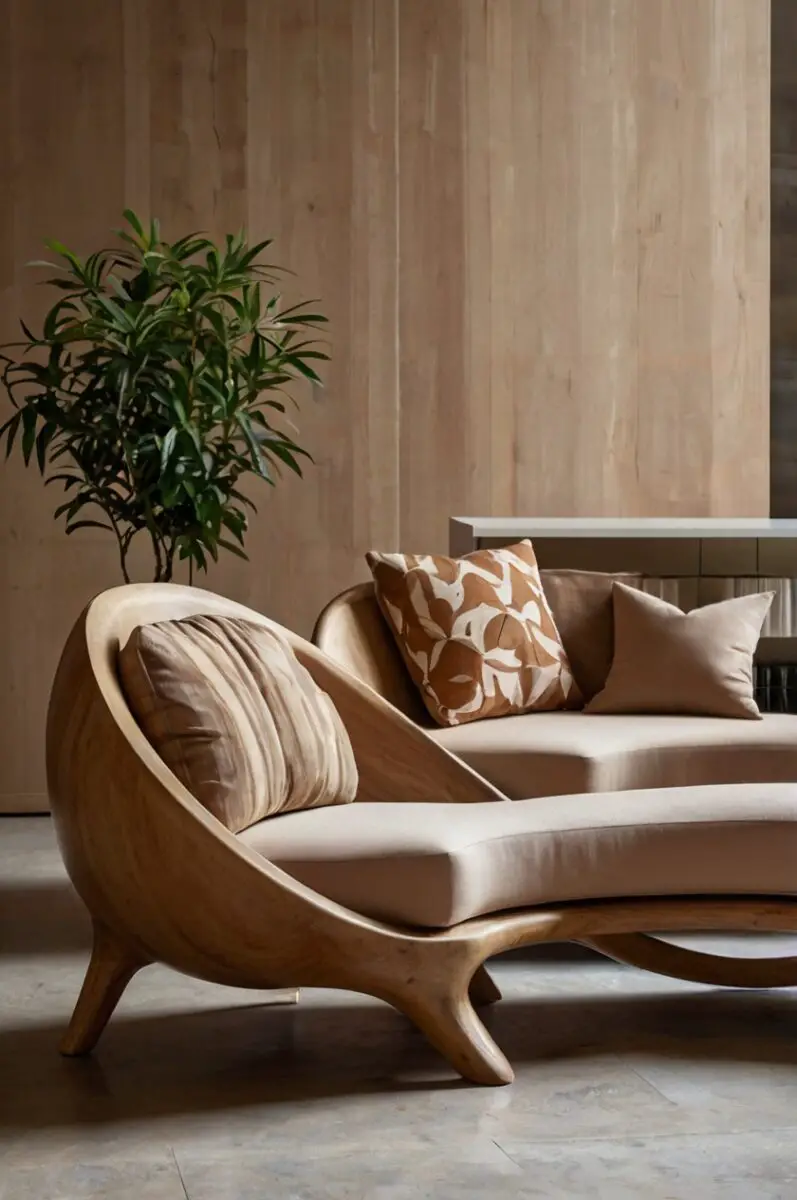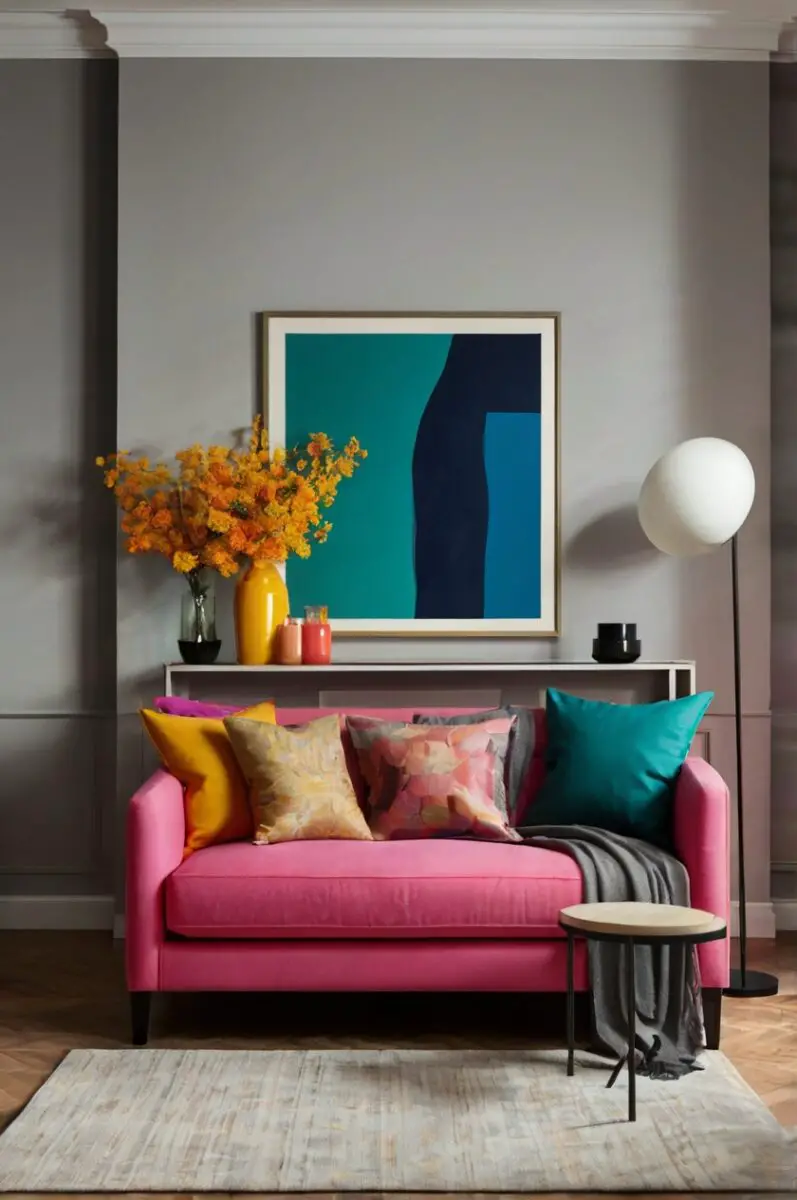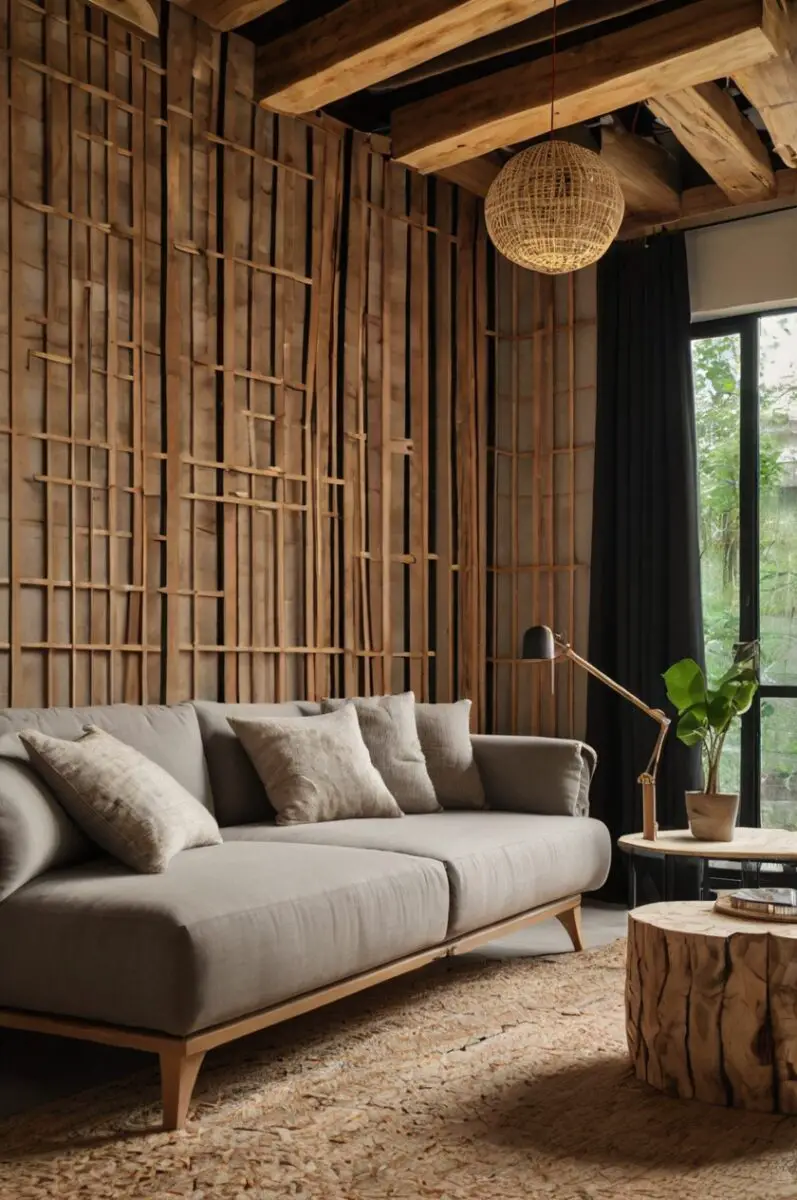Your home should be more than just four walls – it should be a reflection of your personality and a sanctuary that energizes you every single day.
Modern home decor has evolved beyond simple trends, embracing bold statements, functional beauty, and innovative materials that create spaces you’ll never want to leave.
Statement Walls That Scream Personality


Forget everything you know about accent walls because 3D textured surfaces are taking center stage in modern homes.
You can transform any boring wall into a conversation starter by installing wood slat panels, fluted MDF, or even geometric concrete tiles that create dramatic shadows throughout the day.
The magic happens when natural light hits these textured surfaces, creating an ever-changing display of depth and dimension that makes your room feel alive.
Popular materials like ribbed wood, stone veneer, and metal panels offer endless possibilities for customization while maintaining that sleek, contemporary vibe.
You’ll find that these statement walls work particularly well behind beds, dining areas, or as a backdrop for your entertainment center.
The key is choosing a texture that complements your existing furniture rather than competing with it.
Vertical wood slats can make ceilings appear higher, while horizontal patterns create the illusion of wider spaces.
You can even incorporate LED strip lighting behind translucent materials for a soft, ambient glow that transforms your wall into a piece of functional art.
Installation has become surprisingly accessible, with many manufacturers offering peel-and-stick options or simple click-lock systems that don’t require professional help.
You’ll want to start with one feature wall to test the waters before committing to larger areas.
The beauty of textured statement walls lies in their ability to anchor a room’s design while providing acoustic benefits that traditional paint simply can’t match.
Your guests will inevitably reach out to touch these surfaces, creating an interactive element that engages multiple senses.
Maintenance is minimal with most modern materials designed to resist dust and fingerprints, making them practical choices for high-traffic areas.
You can enhance the effect by strategically placing artwork or mirrors that reflect the texture, multiplying the visual impact throughout your space.
Madison’s Current Obsessions
Bring Life to Shadowy Spaces: 11+ Low-Light Houseplants for Your HomeFloating Furniture Revolution


Gravity-defying furniture pieces are reshaping how we think about space and creating rooms that feel impossibly spacious and effortlessly cool.
You can achieve this weightless aesthetic with wall-mounted nightstands, floating TV consoles, and suspended shelving systems that make cleaning underneath a breeze.
The psychological impact of floating furniture extends beyond mere aesthetics – it tricks your brain into perceiving rooms as larger and more open than they actually are.
Modern mounting hardware has evolved to support substantial weight while remaining completely invisible, allowing heavy items like entertainment centers to appear magically suspended.
You’ll discover that floating desks create perfect home office spaces without the visual bulk of traditional furniture legs cluttering your floor.
Bathrooms benefit enormously from floating vanities that showcase beautiful tile work while providing easy access for cleaning.
The minimalist approach extends to bedroom design where floating bed frames create a hotel-like atmosphere of luxury and sophistication.
You can customize floating shelves to any length or configuration, creating asymmetrical displays that break away from traditional symmetrical arrangements.
Cable management becomes infinitely easier when furniture doesn’t touch the floor, allowing wires to run cleanly along walls without awkward gaps or visible routing.
Your lighting design gains new possibilities when floor space opens up, enabling creative placement of floor lamps and accent lighting.
The absence of furniture legs eliminates visual interruptions, creating cleaner sight lines that make spaces feel more cohesive and intentional.
You’ll find that floating furniture works particularly well in small apartments where every square inch of floor space matters.
Installation requires careful attention to wall construction and proper anchoring, but the payoff in visual impact and functionality makes the effort worthwhile.
The floating furniture trend aligns perfectly with smart home technology, as wall-mounted pieces can easily incorporate charging stations and hidden cable runs.
Design Your Dream Room in Minutes! By DreamyHomeStyle
🏡 Start Creating FREE →Madison’s Current Obsessions
15 Ways to Achieve a Warm and Inviting Home Through Thoughtful Interior DesignSmart Lighting That Adapts to Your Life

Intelligent lighting systems are replacing basic switches with technology that learns your habits and automatically adjusts to enhance your mood, productivity, and sleep patterns.
You can program your lights to gradually brighten as morning alarm approaches, mimicking natural sunrise to help your body wake up more naturally.
Color temperature adjustment throughout the day supports your circadian rhythm, shifting from energizing cool whites during work hours to warm, relaxing tones in the evening.
Voice control integration means you can adjust any light in your home without leaving your couch or searching for switches in the dark.
You’ll find that smart bulbs offer millions of color combinations, allowing you to create custom scenes for different activities like reading, entertaining, or romantic dinners.
Motion sensors eliminate the fumbling for light switches while providing security benefits by automatically illuminating pathways when you move through your home at night.
Smartphone apps give you complete control over your lighting from anywhere in the world, letting you simulate occupancy while traveling or ensure you never come home to a dark house.
You can synchronize your lights with music, creating immersive entertainment experiences that transform movie nights and parties into unforgettable events.
Energy monitoring features help you track consumption and optimize efficiency, often resulting in lower electricity bills despite enhanced functionality.
The integration with other smart home devices creates powerful automation scenarios where lights respond to door sensors, temperature changes, or calendar events.
You’ll discover that different zones can operate independently, allowing family members to customize their personal spaces without affecting others.
Daylight sensors automatically adjust artificial lighting based on natural light levels, maintaining consistent illumination throughout changing weather conditions.
Emergency backup features ensure critical lights remain operational during power outages, providing safety and peace of mind.
The aesthetic appeal of smart fixtures often surpasses traditional alternatives, with sleek designs that complement modern decor while hiding advanced technology.
Madison’s Current Obsessions
13 Luxury Design Elements To Include In Your Future ApartmentBiophilic Design Beyond Basic Plants

Living walls, moss installations, and integrated planters are transforming homes into green sanctuaries that improve air quality while creating stunning visual focal points.
You can install vertical garden systems that turn empty walls into thriving ecosystems, bringing nature indoors in ways that traditional potted plants simply can’t match.
Hydroponic growing systems allow you to cultivate fresh herbs and vegetables year-round, combining functionality with the aesthetic appeal of green architecture.
The psychological benefits of biophilic design extend far beyond visual appeal, with studies showing reduced stress levels and improved cognitive function in green spaces.
You’ll find that preserved moss walls require zero maintenance while providing the calming presence of nature without concerns about watering or sunlight requirements.
Water features like indoor fountains or reflecting pools introduce the soothing sounds of flowing water while adding humidity that benefits both plants and human comfort.
Natural materials like live-edge wood tables, stone countertops, and bamboo flooring create connections to the outdoors that satisfy our innate need for natural elements.
You can incorporate living furniture pieces like planters built into coffee tables or headboards with integrated succulent displays that blur the lines between furniture and garden.
Air-purifying plant varieties such as snake plants, pothos, and peace lilies work overtime to filter toxins while requiring minimal care from busy homeowners.
The strategic placement of mirrors amplifies natural light and reflects greenery throughout your space, multiplying the visual impact of your plant collection.
You’ll discover that seasonal rotation keeps your biophilic design fresh and engaging, with different plants taking center stage as conditions change throughout the year.
Technology integration allows automated watering systems and grow lights to maintain your green spaces with minimal intervention, perfect for frequent travelers.
The combination of living and preserved elements creates year-round green spaces that maintain their beauty regardless of seasonal changes or care lapses.
Natural scents from aromatic plants like lavender, rosemary, and eucalyptus provide aromatherapy benefits that synthetic fragrances can’t replicate.
Madison’s Current Obsessions
Explore Magic With 10+ Afrohemian Decor IdeasMixed Metals and Industrial Elegance

The days of matching every metal finish in your home are over – strategic mixing of copper, brass, black iron, and stainless steel creates sophisticated layers that add depth and personality.
You can combine warm metals like brass and copper with cool stainless steel to create visual tension that keeps spaces interesting without overwhelming the senses.
Industrial elements like exposed pipes, metal beam accents, and wire mesh panels bring urban loft vibes to any space while maintaining functional benefits.
The key to successful metal mixing lies in maintaining consistent undertones and ensuring one metal family dominates while others provide accent notes.
You’ll find that black metal fixtures ground any color palette while providing a modern alternative to traditional chrome that feels fresh and contemporary.
Patina finishes on copper and brass add character that develops over time, creating living surfaces that gain beauty through age and use.
Raw steel elements can be sealed to prevent rust while maintaining their industrial aesthetic, perfect for shelving, table legs, or architectural details.
You can incorporate metal mesh screens as room dividers or cabinet inserts that provide texture while maintaining sight lines and airflow.
The contrast between matte and polished finishes within the same metal family adds subtle sophistication that elevates the overall design.
Vintage industrial pieces like factory stools, metal lockers, or repurposed machinery bring authentic character that new pieces often lack.
You’ll discover that metal accents work particularly well in kitchens where mixing brass faucets with stainless appliances creates a curated, designer look.
The durability of metal elements makes them ideal for high-traffic areas where other materials might show wear, providing both beauty and practicality.
Lighting fixtures offer perfect opportunities to introduce mixed metals, with pendant lights and chandeliers serving as jewelry for your rooms.
The industrial trend extends to decorative objects where metal sculptures, geometric forms, and repurposed industrial tools become conversation-starting art pieces.
Madison’s Current Obsessions
Elevating Your Home With 13 Elegant Color SchemesCurved Furniture and Organic Shapes

Angular furniture is giving way to soft, curved pieces that create more inviting spaces while adding sculptural interest that transforms functional items into works of art.
You can soften harsh architectural lines with rounded sofas, kidney-shaped coffee tables, and curved accent chairs that provide visual relief from rectangular room layouts.
The psychological impact of curved furniture reduces stress and creates more welcoming environments that encourage relaxation and social interaction.
Sculptural seating pieces like egg chairs, curved sectionals, and round ottomans become focal points that anchor room designs while providing comfortable gathering spots.
You’ll find that curved elements improve traffic flow by eliminating sharp corners that create bottlenecks and potential injury hazards in busy households.
Organic shapes inspired by nature bring biomorphic design indoors, with furniture that mimics stones, clouds, or flowing water for a calming, natural aesthetic.
The manufacturing advances in molded materials allow for seamless curves that were previously impossible or prohibitively expensive to achieve.
You can layer different curved elements like round mirrors, arched doorways, and circular rugs to create cohesive themes that feel intentional and sophisticated.
Curved kitchen islands break away from traditional straight lines while improving functionality by providing better sight lines and conversation flow.
The interplay between curved furniture and angular architecture creates dynamic tension that adds visual interest without overwhelming the space.
You’ll discover that rounded edges make furniture safer for families with children while maintaining the sophisticated aesthetics that adults appreciate.
Upholstered curved pieces offer opportunities to showcase beautiful fabrics that drape naturally over rounded forms, creating elegant silhouettes.
The trend extends to built-in elements like curved bookcases, arched niches, and rounded breakfast nooks that add architectural interest.
Curved furniture photographs beautifully, creating Instagram-worthy vignettes that showcase your design sensibility while providing comfortable, functional living spaces.
Madison’s Current Obsessions
How To Infuse Your Home With Mediterranean Charm : 10+ IdeasBold Color Blocking Techniques


Strategic color blocking transforms neutral spaces into dynamic environments by creating deliberate contrasts that energize rooms without overwhelming them.
You can paint geometric shapes directly on walls, use contrasting furniture groupings, or arrange accessories in color families that create visual impact.
The technique works particularly well in open floor plans where different color zones help define separate functional areas without physical barriers.
Monochromatic color blocking uses varying shades of the same hue to create sophisticated depth while maintaining a cohesive, calming atmosphere.
You’ll find that unexpected color combinations like deep forest green with blush pink or navy blue with burnt orange create memorable spaces that reflect your personality.
The 60-30-10 rule provides a framework where your dominant color covers 60% of the space, secondary color takes 30%, and accent color appears in 10% for perfect balance.
Temporary color blocking through removable wallpaper, large artwork, or furniture arrangement allows you to experiment without permanent commitment.
You can use color blocking to highlight architectural features like alcoves, built-ins, or interesting ceiling details that might otherwise go unnoticed.
The psychological effects of color blocking can influence mood and behavior, with energizing colors in work areas and calming tones in relaxation spaces.
Seasonal color blocking keeps your space fresh by rotating accessories, textiles, and small furniture pieces to reflect changing seasons and personal moods.
You’ll discover that color blocking works especially well in children’s spaces where bold, playful combinations stimulate creativity and imagination.
The technique extends to outdoor spaces where weather-resistant furniture and accessories create colorful vignettes on patios and balconies.
Digital tools and apps help you visualize color combinations before implementation, reducing the risk of expensive mistakes or design regret.
Color blocking can camouflage architectural flaws or awkward proportions by drawing attention to positive features while minimizing problematic areas.
Madison’s Current Obsessions
Why A Modern Mexican Home Is The Trend You’ll Want To Follow—Get Ready To Be Inspired!Multifunctional Spaces That Work Harder

Modern homes demand furniture and room layouts that serve multiple purposes, maximizing functionality without sacrificing style or comfort.
You can transform any room into a flexible space with murphy beds, expandable dining tables, and storage ottomans that adapt to changing needs throughout the day.
Home offices that double as guest rooms require strategic furniture placement and dual-purpose pieces that maintain professional aesthetics while providing comfortable accommodation.
The rise of remote work has created demand for kitchen islands that function as dining tables, work surfaces, and homework stations for busy families.
You’ll find that modular furniture systems allow you to reconfigure spaces for different activities, from intimate conversation areas to large entertainment zones.
Hidden storage solutions built into stairs, window seats, and platform beds maximize space efficiency while maintaining clean, uncluttered aesthetics.
Sliding doors and room dividers create privacy when needed while opening up spaces for larger gatherings or different traffic flow patterns.
You can design entertainment centers that transform into bar areas, exercise spaces, or craft rooms depending on your current needs and lifestyle demands.
The key to successful multifunctional design lies in choosing pieces that look intentional in all their configurations rather than appearing compromised or temporary.
Technology integration allows spaces to transform with automated furniture, adjustable lighting, and retractable screens that support different functions seamlessly.
You’ll discover that vertical storage solutions and wall-mounted elements free up floor space for multiple activities while maintaining organized, functional environments.
Flexible seating arrangements using poufs, floor cushions, and lightweight chairs accommodate varying group sizes without permanent furniture commitment.
The planning process requires careful analysis of your daily routines to ensure multifunctional spaces truly serve your lifestyle rather than creating additional complexity.
Madison’s Current Obsessions
How to Decorate Your Small Apartment with Big Style : 13 IdeasSustainable Materials Revolution

Eco-friendly materials are becoming the luxury choice in modern homes, with reclaimed wood, recycled metals, and sustainable textiles offering both environmental benefits and unique aesthetic appeal.
You can incorporate bamboo flooring, cork walls, and hemp textiles that provide durability and beauty while supporting responsible environmental practices.
Reclaimed wood brings character and history into modern spaces through barn doors, accent walls, and furniture pieces that tell stories while reducing waste.
The carbon footprint of your home decreases significantly when you choose locally sourced materials that support regional craftspeople while minimizing transportation impacts.
You’ll find that sustainable materials often age more beautifully than synthetic alternatives, developing patina and character that enhance their appeal over time.
Recycled glass countertops, tiles, and decorative objects create stunning surfaces while diverting waste from landfills and reducing demand for new raw materials.
Living materials like cork and bamboo naturally resist moisture and bacteria, making them ideal choices for kitchens and bathrooms where hygiene matters most.
You can support artisan communities by choosing handcrafted items made from sustainable materials, adding authentic character while promoting fair trade practices.
Energy-efficient manufacturing processes for sustainable materials often result in superior quality and longer lifespans compared to mass-produced alternatives.
The aesthetic appeal of natural materials creates calming environments that connect you to nature while supporting your values and environmental consciousness.
You’ll discover that many sustainable options cost less over time due to their durability and minimal maintenance requirements compared to cheaper synthetic alternatives.
Indoor air quality improves dramatically with natural materials that don’t off-gas harmful chemicals like many conventional building materials and furnishings.
Madison’s Current Obsessions
13 Design Tricks Professional Home Stagers Use Every DayDigital Art and Tech Integration

Smart frames, projection mapping, and digital displays are revolutionizing how we experience art at home, creating dynamic galleries that change with your mood and preferences.
You can rotate through thousands of artwork options with digital frames that display everything from classical masterpieces to your personal photography collection.
Interactive wall projections turn any surface into an immersive experience, with apps that respond to movement, music, or voice commands for personalized entertainment.
The affordability of digital art means you can access works from renowned artists and emerging creators without the significant investment required for original pieces.
You’ll find that programmable displays can complement your decor by automatically adjusting colors and themes to match seasonal changes or special occasions.
Virtual reality art experiences allow you to walk through famous museums and galleries from your living room, bringing global culture into your personal space.
Smart home integration means your digital art can respond to lighting conditions, weather, or calendar events, creating truly personalized environments.
You can support digital artists directly through blockchain platforms while building collections that exist in both physical and virtual spaces.
The technology eliminates concerns about fading, damage, or theft that come with traditional artwork while providing unlimited flexibility for rearrangement.
Augmented reality applications let you preview how digital and traditional artworks will look in your space before making purchase decisions.
You’ll discover that digital art opens up possibilities for kinetic and animated pieces that bring movement and life to static wall spaces.
Your home should evolve with your life, and these modern decor ideas provide the foundation for creating spaces that are both beautiful and functional.
The key is choosing elements that resonate with your personal style while embracing innovation that makes daily life more enjoyable and effortless.


